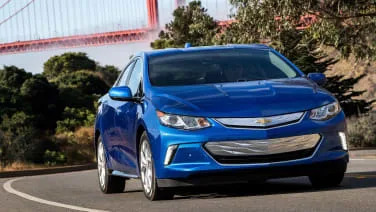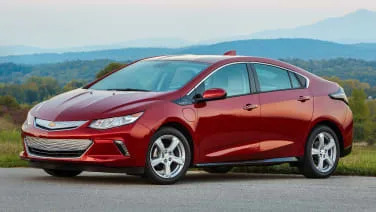LT 4dr Hatchback
2016 Chevrolet Volt
There's a hit vehicle hiding in GM's formula for the Chevy Volt. You can sense it in the enthusiasm that current Volt drivers have for their cars. You can see it in the amount of money GM has poured into its extended-range electric vehicle project. And perhaps most importantly, you can feel it from the driver's seat of the new, second-gen model. The big question is whether or not GM will be able to turn its much-hyped 'halo car' into a best-seller this time around. After driving it in northern California, I can tell you that the Volt is tremendous. But we all know it takes more than that to create a hit. GM has so far sold over 82,000 Volts in the US. That's respectable, but in the early, glory days before the car launched, company representatives were talking about much more impressive numbers. With a few years to talk to customers and potential prospects, GM has learned a lot about what makes someone buy a Volt. For the 2016 model, Chevy has changed just about everything for the better. The new Volt has more all-electric range (53 miles vs. 38 in the first generation), is more fuel efficient whether you're looking at the overall value (106 combined MPGe vs. 98) or just when the car burns gas (42 miles per gallon vs. 37). All of that means that the car's overall range is bumped up to 420 miles, from 380. The battery is smaller and lighter while offering more energy capacity. The range-extending gas engine is bigger (1.5 liters vs. 1.4) but it's also more efficient and can burn regular gasoline instead of just premium. The Volt's overall range is bumped up to 420 miles, from 380. The cost is lower, too: $33,995 vs. $34,170, before incentives. This is a car that GM thinks will compete against the Toyota Priuses and Nissan Leafs of the world (as its new ads make abundantly clear). All three cars have completely different powertrains, but we all know that they're the headline green cars of our time (along with Tesla), so buyers will have to want to pony up a bit more money if they like what the Volt is offering. The 2016 Leaf with its 107-mile range starts at $37,640 (before incentives), while a 2015 Prius can be had for $25,035 (pricing for the 2016 has not yet been announced). So, on paper, the new Volt is an all-around winner. I'm here to tell you that it wins on the road, too. You can't help but notice the changes. They are literally front and center. When GM introduced the first Volt, the world was enamored by chic while iPods, and the Volt design team thought a giant, touch-sensitive panel was a way to make us love their plug-in car. Instead, that was one of the worst features of the first Volt. In the new model, the panel has been deleted like skeuomorphic design in iOS. In it's place is a perfectly …
Full Review
There's a hit vehicle hiding in GM's formula for the Chevy Volt. You can sense it in the enthusiasm that current Volt drivers have for their cars. You can see it in the amount of money GM has poured into its extended-range electric vehicle project. And perhaps most importantly, you can feel it from the driver's seat of the new, second-gen model. The big question is whether or not GM will be able to turn its much-hyped 'halo car' into a best-seller this time around. After driving it in northern California, I can tell you that the Volt is tremendous. But we all know it takes more than that to create a hit. GM has so far sold over 82,000 Volts in the US. That's respectable, but in the early, glory days before the car launched, company representatives were talking about much more impressive numbers. With a few years to talk to customers and potential prospects, GM has learned a lot about what makes someone buy a Volt. For the 2016 model, Chevy has changed just about everything for the better. The new Volt has more all-electric range (53 miles vs. 38 in the first generation), is more fuel efficient whether you're looking at the overall value (106 combined MPGe vs. 98) or just when the car burns gas (42 miles per gallon vs. 37). All of that means that the car's overall range is bumped up to 420 miles, from 380. The battery is smaller and lighter while offering more energy capacity. The range-extending gas engine is bigger (1.5 liters vs. 1.4) but it's also more efficient and can burn regular gasoline instead of just premium. The Volt's overall range is bumped up to 420 miles, from 380. The cost is lower, too: $33,995 vs. $34,170, before incentives. This is a car that GM thinks will compete against the Toyota Priuses and Nissan Leafs of the world (as its new ads make abundantly clear). All three cars have completely different powertrains, but we all know that they're the headline green cars of our time (along with Tesla), so buyers will have to want to pony up a bit more money if they like what the Volt is offering. The 2016 Leaf with its 107-mile range starts at $37,640 (before incentives), while a 2015 Prius can be had for $25,035 (pricing for the 2016 has not yet been announced). So, on paper, the new Volt is an all-around winner. I'm here to tell you that it wins on the road, too. You can't help but notice the changes. They are literally front and center. When GM introduced the first Volt, the world was enamored by chic while iPods, and the Volt design team thought a giant, touch-sensitive panel was a way to make us love their plug-in car. Instead, that was one of the worst features of the first Volt. In the new model, the panel has been deleted like skeuomorphic design in iOS. In it's place is a perfectly …
Hide Full Review
Hide Full Review
Retail Price
$33,170
MSRP / Window Sticker Price
| Engine | I-4 |
| MPG | |
| Seating | 5 Passengers |
| Transmission | 1-spd auto |
| Power | 101 @ 5600 rpm |
| Drivetrain | front-wheel |
Smart Buy Program is powered by 





